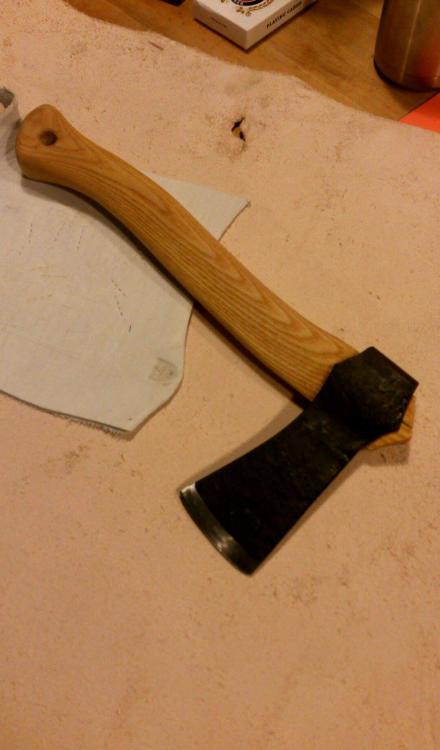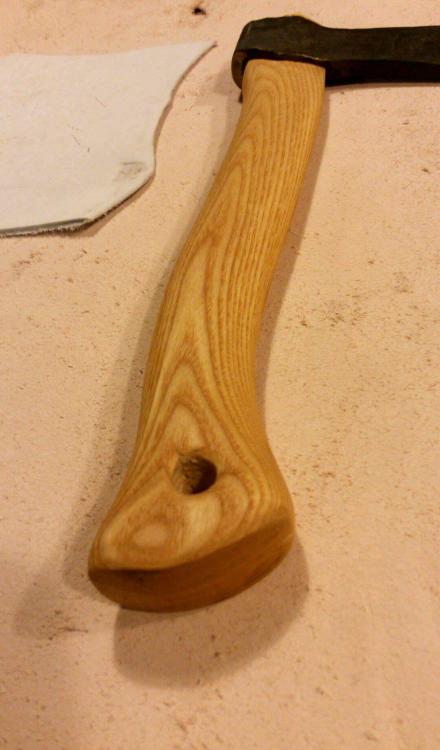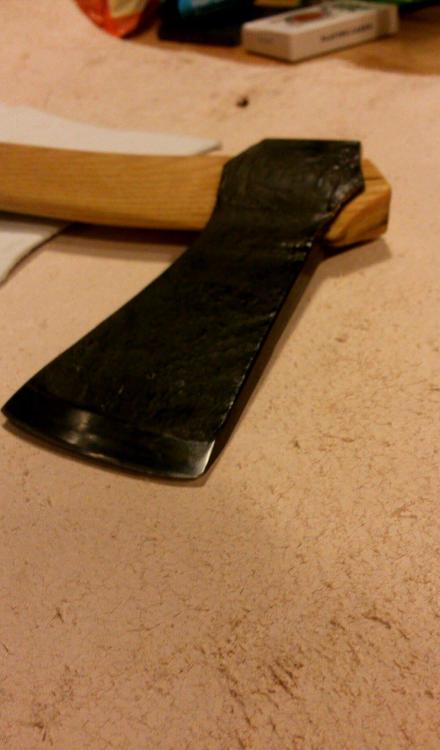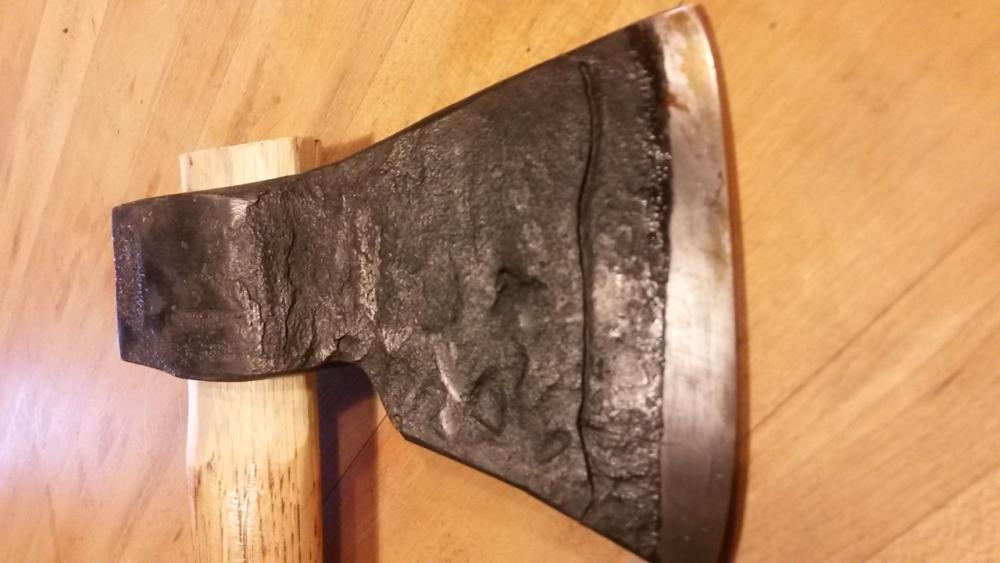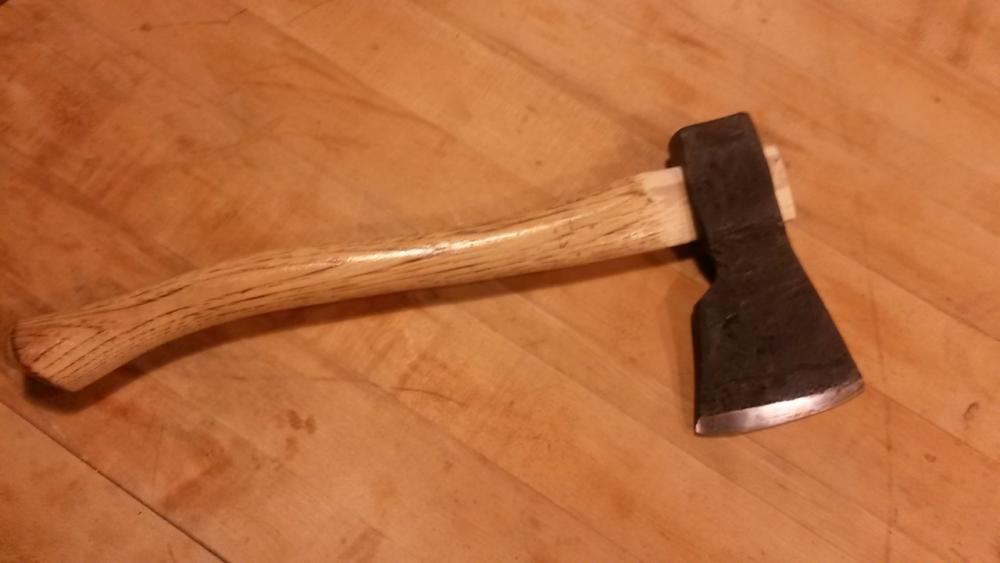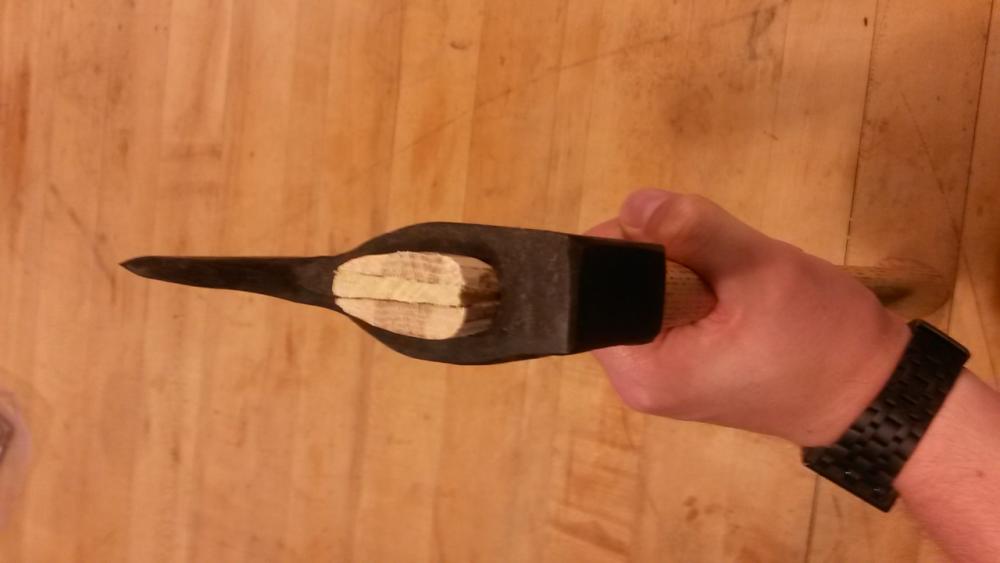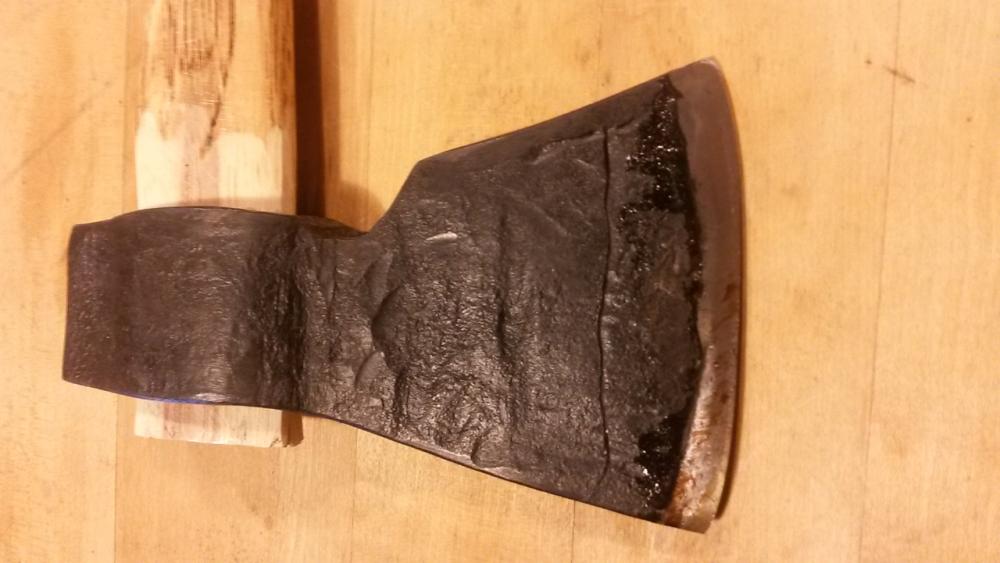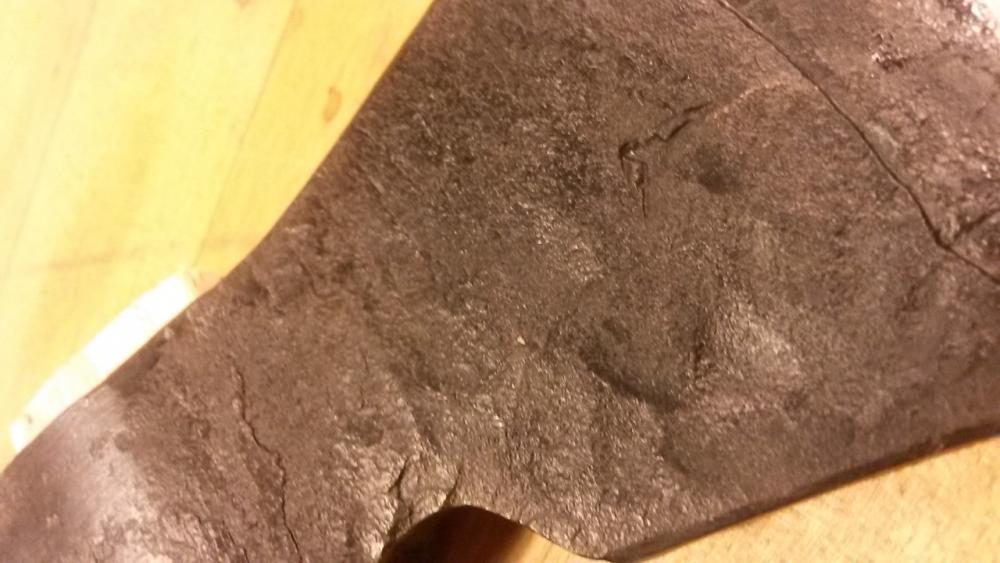-
Posts
378 -
Joined
-
Last visited
Content Type
Profiles
Forums
Articles
Gallery
Downloads
Events
Everything posted by Benton Frisse
-
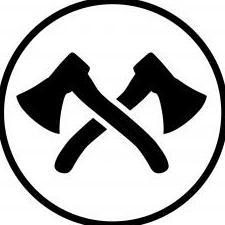
Need some advice - beginner
Benton Frisse replied to Floki's topic in Axes, Hatchets, Hawks, Choppers, etc
Welcome, Floki! Love your name, that's my favorite character from Vikings! I agree that it may be best to practice some more skills before you tackle this endeavor. The best way in my opinion would be to draw the eye material out a bit thinner, do an asymmetrical eye wrap and weld a scarf, but that's a pretty tough technique to knock out. There's probably an easier way and you're at the best place on the net to find that I'd grab some cheaper mild steel and practice this technique before you give 'er a whirl on some good expensive steel. But, one way to learn is to try! Your enthusiasm is great! Keep at it. Check out Rowan Taylor on YouTube. He does a video forging an asymmetrical eye technique and the forging of the eye and the scarf is a doozie. I believe he does it on his trade hawk video. Great stuff. Clear, clean, and concise. These are great vids to take notes along to. He explores some wonderful old techniques. Cheers and best of luck! -
Good lookin' stuff, hello to a fellow Hoosier!
-
Thanks, Gentlemen!
-
Do you put anything on the micarta when you're finished, like a oil or finish?
-
Hey Folks! I found some great reference material in the Knife Making Classes section... I learn something new each time I go there! I didn't see much on finishing micarta, however. What's your guys favorite way to finish micarta? Do you polish it up? Do you leave it rough? I've been sanding to a 200 grit and hitting it with a light coat of mineral oil to make the layers really pop... but I'm not too happy with my finish. Thanks!
-

Bow Tie Camp Hatchet
Benton Frisse replied to Benton Frisse's topic in Axes, Hatchets, Hawks, Choppers, etc
I bet I can find some on USA Knifemaker. I need to get a small press for fluting tubes! -
Nice clean work!
-

viking axe class
Benton Frisse replied to teenylittlemetalguy's topic in Axes, Hatchets, Hawks, Choppers, etc
I have one of his viking ax DVD's and it's a fabulous quality. Clear, perfectly audible, and you can see what he's doing, too! Worth every penny!- 33 replies
-
- broad axe
- viking axe
-
(and 1 more)
Tagged with:
-

Good steels for swords and the perfect grinds
Benton Frisse replied to Northwoodsman's topic in Swordsmithing
I was probably going to try my hand first at a long dagger/short sword since I've never forged a long blade, probably a 12-15 inch blade. Hopefully working my way up from there. I have access to a 48' heat treat oven here in Indiana. Mine is only 16 inches deep. Here are the specs per NJ Steel Baron: Chemistry/CertificationCertification: C- .916 Si- .296 Mn- .215 P- .0050 S- .0020 Cr- .069 Ni- .042 Mo- .008 V- .165 W- .005 Cu- .047 Sn- .0060 Al- .006 Annealed Structure: 98% spherodized carbides -

Twin Dragonscale Drawknives
Benton Frisse replied to bobasaurus's topic in Chisels, Gouges, Scissors, etc
Wow! Beautiful... all three pieces! -

Bow Tie Camp Hatchet
Benton Frisse replied to Benton Frisse's topic in Axes, Hatchets, Hawks, Choppers, etc
Bob, that's the one I was referring to! Had the wrong smith Thanks for the kind words! TP, how'd you know I forged this while wearing my thong?! Just kidding, I love that idea and I may try to do that. Think I should flare the ends like flare tubing or make it flush and epoxy it/wood glue? -
Just finished this one up, still need to cut leather for it. I like doing this folded style, and my goal was to try to forge the langets pointed this time instead of rounded. I've been really working towards teaching myself this style where the eye is forged with alternating fullers. Rowan Taylor has a great video about it on his YouTube channel on forging an Anglo Saxon axe. I think James Austin had a piece in the Hammer's Blow a year ago or so about this style. I'd like to get to where I can forge larger pieces this way. Has anyone tried the asymmetrical wrapped eye technique? If so, what are your thoughts? That's next on my list. Mild and 5160, forged from 8.25in of mild. Ash handle. Heat treat at 440F for 1.5 hours.
-
Love this design! Awesome work.
-

Hewing Axe step by step (pic heavy)
Benton Frisse replied to Judson Yaggy's topic in Axes, Hatchets, Hawks, Choppers, etc
Beautiful work! -

viking axe class
Benton Frisse replied to teenylittlemetalguy's topic in Axes, Hatchets, Hawks, Choppers, etc
My gosh, I'm very jealous. I would love to get into one of Jim Austin's classes! He does such beautiful work. Nice looking stuff, sir!- 33 replies
-
- broad axe
- viking axe
-
(and 1 more)
Tagged with:
-

Good steels for swords and the perfect grinds
Benton Frisse replied to Northwoodsman's topic in Swordsmithing
Hey Folks! Since we're discussing steels, long blades, and grinds... I have read that a lot of people favor (or at least enjoy) working W-2 for long blades. What is everyone's general opinion on this steel? NJ Steel Baron currently has it in stock. From what I've read, seems to be a relatively forgiving steel for forging and heat treat. -
Finished this one a few weeks ago. Forged from 1x2x3 mild with a leaf spring bit. Found fractures from the spring, I think, once I was doing some final grinding. I worked the bit nice and hot, so I'm thinking it was from previous fractures. Came out right at a pound and a half and stuck it on a cheap Link handle from Rural King. Can't wait to make more like this, my Brent Bailey axe drift is my new favorite tool! Next time, i'll make sure I set my bit further back so I don't have that nasty line where the bit meets the mild steel. All welds are solid. it's a little dirty here, I had already gave it a few test runs.
-
Beautiful work! Just beautiful.
-
Chris, you never cease to amaze me. Beautiful work!
-
Sorry I'm jumping in a little late. I really like 5160 for my hawks. Easy to come by, go snag some old leaf springs, and hardens easy enough, too. A lot of folks who manufacture tomahawks use 5160. Granted, not all leaf springs are 5160. I like that they come in a nice stock, too. 1/4 to 3/8 in thick, 2 inches wide, you can forge them into many applications.
-

one-piece hawk
Benton Frisse replied to matei campan's topic in Axes, Hatchets, Hawks, Choppers, etc
Stunning! Incredible work! -

Struggling with tomahawks
Benton Frisse replied to Anthony Karakas's topic in Axes, Hatchets, Hawks, Choppers, etc
I find that when drifting open the eyes on RR spikes for hawks, there are two important factors: Temperature and making sure your first punch or slit is center. For hawks made of a RR spike, I upset the spike end to approx. 3/4 in, then I slit my eye where I want it. If your eye isn't hot enough when drifting you're going to blow out the lug every time. Get a good hot heat and work it till it starts to get an orange then put it back in the fire. Better safe than sorry. In terms of making your eye center on your material, if you are too far to either side, when you start drifting one side will be thinner and you could end up blowing out that side as well. I fried probably 10-15 spikes by cracking the eye before I realized I have to keep it hot and have my center punches right. Also, might help using a different drift. From the research I've done and experience, when doing a drifted eye type of axe, be it RR spike, or mild with a welded bit, you don't want any sharp corners in the eye of the ax. James Austin states in his "Forging a Viking Broad Axe" DVD that you don't want any hard or sharp angles inside they eye. I'd hit Kayne & Son's website, pick up a 15 dollar tomahawk drift or mouse hawk drift and use those. They're tear drop shaped. That way you can just plug a handle in and go once you're complete. Also, in terms of getting the crack after drifting and during shaping, if you forge out your shape then decide to punch/slit/drift your eye, it's hard to get a good position over the hardy to punch/slit/drift through once you've forged your shape. If you do it prior to forging, it's still relatively square and sits on the anvil and over the hardly relatively easy still. Also, in my opinion (we all know what opinions are like, an orifice that stinks and we've all got 'em) drifting your eye to a near completed shape and size before lets you utilize the rest of the material more and in a better way, and you can move that metal to where you need it, working your final shape from the stock near the eye out towards the bit of the blade. Whereas punching after, you could have more material than anticipated, or not enough for the transition from the eye to the blade of the axe. Sorry to ramble a bit, I hope this helps. -
Great looking pattern, whoda thunk barbed wire could be used for pattern welding!? Awesome idea!
-

First Attempt at an Axe
Benton Frisse replied to Dustin Quade's topic in Axes, Hatchets, Hawks, Choppers, etc
Hey Dustin, great start here. I agree with some of the other folks here that a tapered eye (much like a hawk) may be better served in this case, but nonetheless you jumped in and gave something new a whack and did a pretty great job at it. I personally think this ax has a great shape from toe to heel. You can pick up tomahawk drifts from Kayne & Son for pretty cheap. They're cast but they'll get you through for plenty of years until it's time to upgrade to a tool steel one. Next round with a handle, I'd adjust your grain orientation a bit. This one has grain running perpendicular to the bit of the ax, you want it running with it. It'll give you a stronger handle that's less likely to break on impact or a bad throw.- 19 replies
-
- axe
- throwing axe
-
(and 5 more)
Tagged with:
-
Hey JHCC, I'll give it a whirl, thank you! This was intending to be just a standard chisel for wood work. I need to do more research on the different types of chisels. Thank you for the link, Mr. Boggs! I'll give the rounder and horn technique a try.

